
|
|
It's useful to separate the body into [target] areas (from most to least injurious): The red zone includes the head, neck, spine, kidneys and groin; the orange zone includes the torso and pelvic area; and the yellow zone is the limbs. [color added]
|
|
It is absolutely useful to separate the body into target areas (from most to least injurious), but for us the zones are completely different. Our red zone focus is primarily on the limbs. Break them or impact them sufficiently and your assailant is unable to harm you — even if he is on drugs and feels no pain.
|
|
Although Hollywood frequently portrays head butting as part of the hero's defense, in reality the overwhelming majority of attack and defense methods use only arms and legs — specifically hands, feet, elbows, and knees. For any martial artist, then, avoiding an opponent's limbs is crucial — certainly much more important than concerning yourself with potential head-butts. However, practitioners of close-quarter infighting arts do face a unique set of difficulties in this regard. For the infighter (one who fights very close to his opponent), the problem is that the opponent's limbs, when they're not trying to strike or wrap around you, simply get in the way. When this happens, you can pummel them, or you can do something else — capture them and use your attacker's own weapons, his limbs, against him.
Capturing the limb is a fighting tactic and principle of combat that is fundamental to Indonesian fighting arts. Granted, it is not uniquely Indonesian. Grappling arts do this all the time, and Filipino practitioners routinely attack the limbs with both elbows and fists. What is uniquely Indonesian is how close-quarter, predominantly striking arts from that part of the world manage to capture, control, and destroy an assailant's limb as an integral and conscious part of their fight strategy, and without focusing on or drawing attention to it during the fight. But before exploring this strategy and its potential in combat, you need to reorder your thinking. Specifically, you need to reexamine what you think of as "primary" targets. Let's begin with a quick look at the concept of "switches and timers."
Like most folks, you might think that a blow to the head is a switch — you hit someone in the head, lights out, end of fight. That can be the result, and sometimes it is, but more often than not a blow to the head is much more like a timer than a switch. Struck in the head, an individual may be (or appear to be) completely unfazed. He may be somewhat dazed, staggering around semiconscious or otherwise completely unaware of what's going on. The point is that a blow to the head is no guarantee that your opponent will be rendered harmless. Add to this uncertainty the presence of alcohol or drugs, further dampening an individual's reaction to such a blow, and it is little wonder that only John Wayne could end a fight with a single blow (although in the last movie I saw him in, he had to use a pickaxe handle to do that If you want to end the fight quickly, actually incapacitating your opponent, then attack the limbs. No, I am not suggesting that you can end a fight with a single direct blow to the limb, as I am sure some of you already envision, but you really can end a fight by attacking the limbs at every opportunity. For the civilian, non-military martial artist, there is another benefit to this strategy. Namely, a decrease in potential lethality (not to mention reduced legal liability). Please note that less-than-lethal does not mean less effective. In fact, from the standpoint of stopping your assailant cold, that is, rendering him harmless, this approach is more effective than, say, a kick to the head — and a whole lot easier to do. (Personally, I have no desire to go to prison for accidentally killing anyone.) With our thinking sufficiently reordered with regard to so-called "primary" targets, let's look now at three examples of how this strategy of attacking the limbs is used in combat. (For demonstration purposes, all of the techniques are shown with the assailant throwing a right punch from a right lead — not particularly realistic, but much better for visual clarity.)
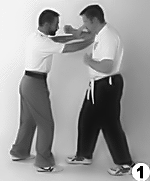 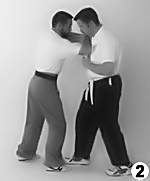 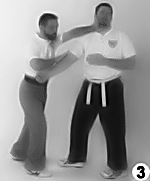
From his left-hand-in-the-face position (fig. 3), the defender now drops his left arm over his opponent's right, capturing it (fig. 4) just before the defender begins a rapid and violent clockwise rotation (fig. 5). The capture MUST be subtle. This is very important. There is no sudden snatch-and-grab, for such a move would very likely trigger a defensive reaction on the assailant's part, thereby forcing the defender to pursue a completely different tact. Again, the capture principle works best when applied with the least effort, leaving the assailant unaware of his predicament until it's too late.
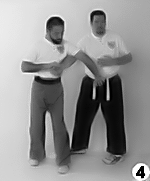 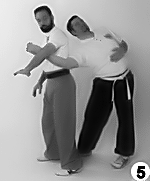
Once he's captured the arm, the defender need only rotate sharply clockwise. Figure 5 shows how the defender's left arm, acting as a lever, actually attacks the assailant's right arm, breaking his elbow against the fulcrum provided by the defender's torso. Follow-up possibilities are numerous, but at this point the defender has already negated his assailant's ability to effectively continue the fight.
  
In one simple stroke, the defender now sweeps his opponent's arm down and to his right (fig. 9). However, far from discarding his assailant's arm, the defender snags it with his right hand and directs it toward the top of his own right hip. At this point, the defender rotates clockwise, simultaneously pulling on his attacker's wrist (the first lever) as he thrusts his left shoulder (the second lever) against his assailant's upper arm, very near his elbow (fig. 10). While the defender can easily break his opponent's arm from here, if he is a kuntao-silat practitioner, he may have another objective. Seeking positional advantage from which to decisively neutralize his foe, the kuntao-silat player first accelerates in a clockwise rotation; his assailant in tow (figs. 10 and 11). Once the assailant reaches the desired velocity, the defender simply folds his own left arm, transferring control of his assailant's arm from the defender's right to his left hand (fig. 11). Then, with his opponent's arm secure, the defender suddenly reverses direction, clotheslining his hapless foe against his onrushing inside right wrist or forearm (fig. 12).
  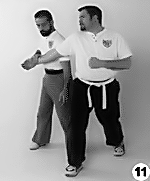 
These are but two examples of how you can use the fighting principle of capturing the limb to quickly and efficiently neutralize an opponent. In the first example, the defender slips his left arm over and down, inside his assailant's right arm, then uses his own torso as the anvil upon which to break it. In the second, the defender again has the option of breaking his opponent's arm but chooses instead to use it to accelerate his assailant into a classic example of combat whiplash. While these are excellent examples, of this fighting principle, I caution you that it is easy to lose sight of the key to its effective use: careful, subtle, almost stealth-like capturing of the limb. In this last example, note how we keep our foe completely off balance, keeping his mind on everything but his captured limb.
Unlike in the previous examples where the defender essentially remains outside his opponent's body and captures the offending limb by reaching inside (either descending from above or reaching up from below), this time the defender's body is inside his attacker's arm.
 
You might feel uncomfortable with an opponent's arm practically wrapping around your middle, perhaps fearing a clinch, but a second "expansion" unfolding from the elbow strike neutralizes that threat. From the elbow strike, a right palm strike unfolds and glances off the opponent's face (fig. 15). This is done with a simultaneous step to the right (fig. 16) that effectively turns the opponent away. The defender, then, loops his right palm back to land a palm strike to the attacker's groin (fig. 17) as he simultaneously rotates 90 degrees counterclockwise (fig. 18). At this point the defender has captured the assailant's right arm between his left elbow and chest. However, the blows already delivered to his hapless foe keep him too distracted to notice the capture and recognize his precarious position.
  
Once the assailant is turning and his momentum begins to build, the defender sharply reverses direction and whips his foe back with a final inside right forearm strike to his neck (fig. 19). As in the previous examples, capturing the limb was, quite literally, pivotal to the success of this defense.
 
(And this is how our technique 3 flows.)
Conclusion Any hand-to-hand combat art that claims close-quarter or infighting as part of its mantra must include as an integral part of its fight strategy a means of controlling or neutralizing an opponent's weapons. Without this key component, the art's efficiency rests solely on its ability to enable the defender to dish out more punishment than he receives. That may be fine for the young, vigorous sport enthusiast, but for most of us, such a fight strategy is clearly out of the question. Capturing the limb is extremely efficient as a fighting tactic because no movement is wasted. Attention and effort are not spent on seizing and attacking the limb alone. Rather, capture and subsequent destruction of the threat are executed on the way to attacking preferred targets like the head and others housing vital organs. Second only to adhesion among Indonesian fundamentals, this principle of combat is one that will radically and forever alter they way you see infighting and close-quarter combat. It may not be as exciting as a head butt on the silver screen, but it's a lot safer for you — and a lot more effective. |
||||||
|
Footnotes:
|
||||||
|
Reflex Action: Training Drills to Fighting Skills. |
|
©Copyright Bob Orlando, 2001-2016 All rights reserved. |
http://www.OrlandoKuntao.com
E-mail: ron@orlandokuntao.net |
Last update:
Aug. 6, 2016 by Bob Orlando |
 ). A dazed opponent, like a wounded animal, still poses a very real threat. This is especially true when edged weapons are involved. An individual may have been stabbed or cut in the torso or even the head and still have the wherewithal to injure or slay his opponent. This is because these timers, while inflicting serious and potentially lethal injuries, usually involve a delay before the opponent reaches the desired state, i.e. harmless. Not so with switches.
). A dazed opponent, like a wounded animal, still poses a very real threat. This is especially true when edged weapons are involved. An individual may have been stabbed or cut in the torso or even the head and still have the wherewithal to injure or slay his opponent. This is because these timers, while inflicting serious and potentially lethal injuries, usually involve a delay before the opponent reaches the desired state, i.e. harmless. Not so with switches.